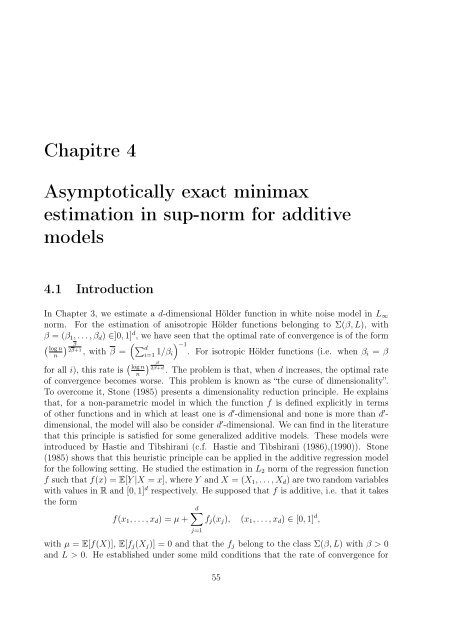THÈSE DE DOCTORAT DE L'UNIVERSITÉ PARIS 6 Spécialité ...
THÈSE DE DOCTORAT DE L'UNIVERSITÉ PARIS 6 Spécialité ...
THÈSE DE DOCTORAT DE L'UNIVERSITÉ PARIS 6 Spécialité ...
- No tags were found...
You also want an ePaper? Increase the reach of your titles
YUMPU automatically turns print PDFs into web optimized ePapers that Google loves.
Chapitre 4Asymptotically exact minimaxestimation in sup-norm for additivemodels4.1 IntroductionIn Chapter 3, we estimate a d-dimensional Hölder function in white noise model in L ∞norm. For the estimation of anisotropic Hölder functions belonging to Σ(β, L), withβ = (β 1 , . . . , β d ) ∈]0, 1] d , we have seen that the optimal rate of convergence is of the form) ( β∑d) −1.2β+1, with β =i=1 1/β i For isotropic Hölder functions (i.e. when βi = β( log nnfor all i), this rate is ( )log nβ2β+d. The problem is that, when d increases, the optimal ratenof convergence becomes worse. This problem is known as “the curse of dimensionality”.To overcome it, Stone (1985) presents a dimensionality reduction principle. He explainsthat, for a non-parametric model in which the function f is defined explicitly in termsof other functions and in which at least one is d ′ -dimensional and none is more than d ′ -dimensional, the model will also be consider d ′ -dimensional. We can find in the literaturethat this principle is satisfied for some generalized additive models. These models wereintroduced by Hastie and Tibshirani (c.f. Hastie and Tibshirani (1986),(1990)). Stone(1985) shows that this heuristic principle can be applied in the additive regression modelfor the following setting. He studied the estimation in L 2 norm of the regression functionf such that f(x) = E[Y |X = x], where Y and X = (X 1 , . . . , X d ) are two random variableswith values in R and [0, 1] d respectively. He supposed that f is additive, i.e. that it takesthe formf(x 1 , . . . , x d ) = µ +d∑f j (x j ), (x 1 , . . . , x d ) ∈ [0, 1] d ,j=1with µ = E[f(X)], E[f j (X j )] = 0 and that the f j belong to the class Σ(β, L) with β > 0and L > 0. He established under some mild conditions that the rate of convergence for55










